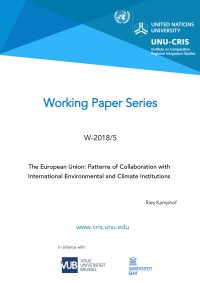The European Union: Patterns of Collaboration with International Environmental and Climate Institutions

The EU and its Member States have had substantive and institutional influences on the UN environmental institutions UNEP and UNFCCC. The EU and its Member States are among the largest funders of the UNEP and the ‘Team EU’ coalition formed during UNFCCC COP21 contributed significantly to the result of the Paris Climate Agreement. While the European Community was a bit behind at the time of the introduction of UNEP (1972), the EU conversely assumed a leadership position when it came to the formation of the UNFCCC in the 1990s. Since ‘Copenhagen’ (2009) the EU moved away from its ambition of legally binding instruments towards more soft yet universal agreements, such as the Paris Agreement and the UN Agenda 2030 with 17 Sustainable Development Goals (SDGs). On an institutional level, one could identify very peculiar institutional arrangements. These arrangements primarily resulted from the unique legal status of the EU as well as the particular legal status of the ‘Program’ and ‘Convention’ within the UN system.
The EU and Member State cooperation in these international institutions is mainly driven by legal (shared) competences, but it is also the result of political pragmatism. This combination could have positive effects on EU-Member State cooperation, as the ingenious ‘Team EU’ arrangement in UNFCCC makes clear. However, the cooperation arrangements also deviate from what is prescribed in the EU Treaties, which is making coordination more time-consuming. Examples include the negotiation mandate based on unanimous Council conclusions, as well as a large coordinating role for the Presidency of the Council of the EU in UNFCCC. By means of the unusual arrangements, as well as the Treaties, the Member States are keen to keep their discretionary autonomy on fiscal issues, land use and energy mix choices.


